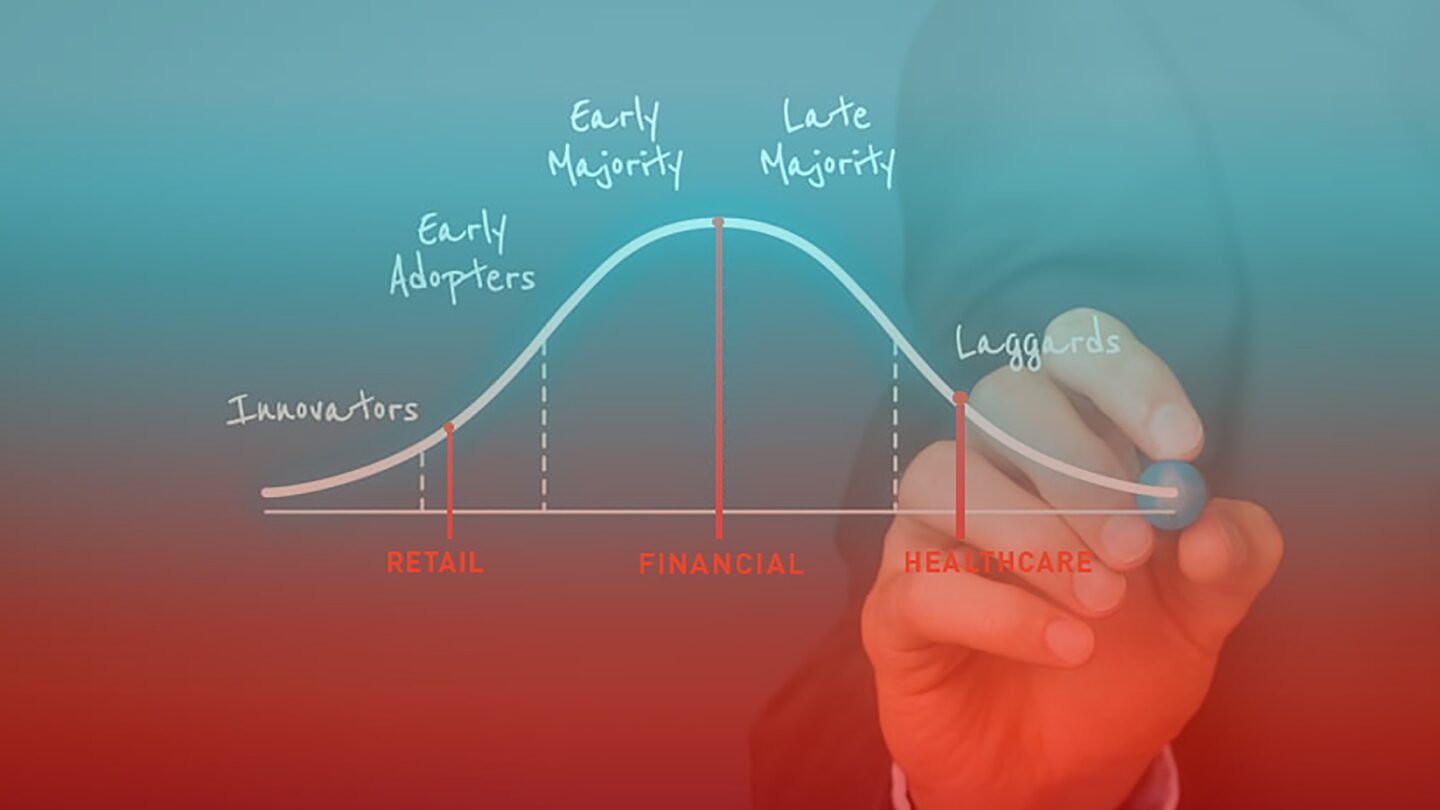In our last healthcare post, Healthcare’s 21st Century Renaissance, we discussed the role of disruption on sectors comparing financial to the healthcare industry.
We know using Rogers’ Diffusion of Innovation Theory that healthcare is only at the beginning phases of disruption, while financial is close to being fully disrupted, as evidenced by mobile banking apps on nearly every smartphone in the country. But for the healthcare consumer, what they see in the healthcare setting is a better barometer of current and future states of the industry. What are experiences in healthcare facilities today compared to what’s coming down the pipe? After all, the healthcare journey is mapped out via the eyes of the consumer.
At Adrenaline, we have a powerful healthcare customer journey mapping process that takes healthcare organizations from point A (current state) to point B (future state) and ladders all healthcare consumer experiences up to a larger strategic whole that is aligned across all of the healthcare brand’s channels of experience. It’s an iterative, flexible approach that allows for healthcare organizations to ready themselves for wave after wave of disruption. But what’s way more interesting to most healthcare consumers is what we expect to see as an end result. After all, unless you’re a chef, you probably don’t really care exactly how the soup is made, but would rather focus on what it tastes like.
So what is the current state of healthcare today? Taking the pulse of the industry, for most healthcare consumers it’s prognosis negative. This is usually an experience ripe full of frustration, wasted time, inconvenience, multiple calls, waiting, and an expectation that you – the healthcare consumer –will learn your healthcare institution’s processes and procedures. After calling in to schedule your appointment, and waiting several days, sometimes weeks, you find yourself sitting in a dated waiting room that is designed more for the healthcare organization than you. You sign a clipboard, wait, see your doctor, wait, check out, and then wait for your prescription. Lots and lots of waiting.
Gina Bleedorn, Chief Experience Officer at Adrenaline, says, “The current state of healthcare is largely dated environments that are not uniquely branded. In other words, your environment could be any doctor’s office USA. These spaces are built for the old model of healthcare where you fill out your name on a clipboard, go sit in an uncomfortable chair and wait until it’s your turn – all without visibility or any information on wait times. Maybe they’re starting to offer Wi-Fi. Maybe. Healthcare institutions are notoriously black holes for cell service, so with no Wi-Fi you sit and wait – disconnected and frustrated that this environment doesn’t support any layer of digital convenience.”
But it’s not simply about introducing one tool to address the host of issues within healthcare. Bleedorn says, “You’ve got industries like retail and largely financial that are very largely digitally disrupted, meaning that any parts of the business that can be digitized are. Whereas, healthcare is far, far behind. The thing to note is that it is coming. It’s coming, whether they’re ready or not. Healthcare is going to be in the same position financial is in now where they’ve got dozens, hundreds, in some cases thousands of environments that have been built and continue to be built until they realize ‘Wait a minute, these are built for experiences that no longer occur in them.’ They are built for an old model of experience. We are trying to help healthcare learn from that through branded environments and experience design.”
Regarding future states, looking at old-school banking can give us a clue as to what’s to come. Bleedorn says, “One of the things is just branding the space so that you have nicer logos, colors and elements that feel branded. You have digital technology. You have nice furniture options and nice configurations of seating. For example, in financial when teller lines were reduced, there were new space plans that could change the function of the space to make it more purposeful and convenient. So we’re helping facilitate a business model change, shifting what can be digitized and automated. Most healthcare clients are not there yet, because the digitization has not become mass market.”
How healthcare can get there is by thinking about what impact technology can have on anything from check-in and check-out and other things that take place with every patient, every day. Bleedorn says, “I think you’ll see check-in kiosks, those are probably going to be leapfrogged just like they were in the airline industry. The true future state for many of the predictable aspects of healthcare is mobile. If you need to see your doctor, you just have to check-in and complete online paperwork and even pay your bill on your mobile. If healthcare does this, they’d no longer need a clipboard or a check-in or check-out desk. Imagine the convenience if that was all digitized, which it really could and should be.”
When healthcare digitizes these aspects, then the physical space becomes about providing services that cannot be delivered by digital means. Bleedorn says, “For financial, that’s consultative advice, opening a new complex account or a loan. For healthcare, that’s illness, checking out symptoms, getting check-ups. For the most part, these cannot be done remotely. There is, however, a rise in investment in telehealth technologies which could be good for common colds or routine visits. Overall, there is a lot more in healthcare that requires you to be physically there, which is one of the reasons I think the industry hasn’t been disrupted as much as financial has, yet.”
According to Bleedorn, the biggest shift in digitization that the healthcare industry will see is when digitization is not just about data, but the digitization of activities. She says, “With online banking, everything really changed. Online banking revolutionized financial. Mobile transformed things further. Remote deposits, that really was a game-changer because wait a minute, I can now just take a piece of paper at my house and deposit it? As transactional things start to happen in healthcare – even starting with things like appointment making and getting prescriptions so I don’t have to go to the pharmacy –we’re going to see the physical spaces needing a big overhaul because of those activities.”





